Abstract
A straightforward and inexpensive electrophoretic method for obtaining environment-friendly nanocrystalline piezo layers from Rochelle salt (RS) is presented here. The electrophoretic deposition process includes the formation of nanocrystals by precipitation of Rochelle salt/water solutions in ethanol (anti-solvent method) under the influence of a high electric field. A nanoporous anodic aluminum oxide membrane is used to separate the electrochemical cell into two chambers. The composition of the RS:H2O:EtOH mixture and the spatial separation of the process of precipitation from electrophoretic deposition allow control of the nanocrystal size and the uniformity of the layer. The reaction kinetics, the morphology, and the piezo response to the resulting layers are all investigated. The best samples were obtained at RS:H2O:EtOH ratio 1:22.5:37.5. Under these conditions, the nanocrystals are preferentially oriented on the aluminum substrate and form a dense and homogeneous layer. Although the obtained structure is polycrystalline, the resulting piezo effect is 1120 pC/N, which is comparable to inorganic monocrystals and piezoceramics. This allows the use of electrophoretically deposited polycrystalline piezo layers in applications such as energy harvesting.
1. Introduction
Dielectric materials with pronounced piezo effect are used in the fabrication of actuators [1], energy harvesting systems, crystal oscillators, surface acoustic wave filters, sensors, and MEMS [2]. The piezo effect is observed for the first time in Rochelle salt [3]. It is inexpensive, and its crystals are obtained by state-of-the-art technology, usually from water solution. Its structure is orthorhombic (group D3 2–P21212) in paraelectric phases and monoclinic (group C2 2–P21) in the ferroelectric phase. Spontaneous polarization is targeted along the crystal axe. It is accompanied by spontaneous shear stress ε4. At the beginning of the 20th century, many piezo devices were created from Rochelle salt, but it was replaced by environmentally unaffected materials due to its hygroscopicity. For instance, crystals with rare elements are obtained at high-temperature processes such as BaTiO3, SrTiO3, and BaTiO3-CaTiO3 [4]. The growth of piezo crystals containing toxic elements such as lead gives large improvements in the coefficient of piezoelectric strain and the coefficient of electromechanical coupling for actuator and transducer applications. More expensive technologies are developed for piezo nanowires of Wurtzite materials, such as ZnO [5], GaN, InN, and ZnS, which simultaneously have piezoelectric and semiconductor properties [6]. To reduce the price of technology processes, ceramic structures with the piezo effect are introduced, with most of them also fabricated by high-temperature processes and/or containing toxic elements (such as PZT). In addition, we need to account for the influence of the porosity on the electrical properties of the piezoelectric ceramics [7,8]. In an attempt to reduce the price and introduce low-temperature technologies, significant attention is paid to piezopolymers (such as PVDF). They have a low piezo modulus compared to crystal substances, and it is beneficial to fabricate composites with various additives to the polymer. For instance, Lee and coauthors [8] improved the piezoelectric behavior of polyvinylidene fluoride (PVDF) films with reduced graphene oxide (RGO) additive. Other authors created PDMS ZnO piezo composites for pressure sensors [9]. Low-temperature sol-gel processing for piezoelectric layering with high performance is a perspective technology. Unfortunately, it requires expensive precursors, a long time for preparation of the sol, and a long time for obtaining the piezoelectric layer; all these restrict the scope of its application [10,11].
For making piezoelectric biosensors and their applications in health monitoring, medical diagnostics, and agriculture, biocompatible piezo materials are studied. These materials should be environmentally friendly, non-toxic, and with low production costs [12]. Similar biocompatible piezo materials can be taken directly from nature (e.g., collagen [13] and chitin [14]), but their piezo modulus is low.
In the search for a low-cost, high-piezo modulus, and biocompatible piezo material, scientists again started to investigate the properties of Rochelle salt, obtaining nanocrystals of tartrate embedded in mesoporous sieves [15], paper sheets [16], and wood matrix [17]. The deposition of crystals in various matrices is a slow method and requires serious preliminary preparation, and respectively the price is not very low. For this reason, we will try to form nanocrystals of Rochelle salt directly on a substrate by the cheap and fast method of ElectroPhoretic Deposition (EPD).
Electrophoresis is the deposition of charged particles in a stable colloidal suspension on a conductive substrate acting as one of two oppositely charged electrodes in the EPD cell [18,19]. The deposited particles form a layer over one of the electrodes when DC voltage is applied. In conventional electrodeposition from aqueous solutions, the alkali metal salts act solely as an additive to improve the deposition process because the salt is highly soluble in water and dissociates into positive and negative ions [20]. The Rochelle salt in aqueous solutions also dissociates into metal ions and negative tartrate anions. When performing electrodeposition in an aqueous environment, this salt is again an additive. Its ions are adsorbed on the powder in the suspension, thus improving its polarity and deposition conditions, respectively [21]. Therefore, when an electric field is applied to an aqueous electrolyte containing Rochelle salt, a crystalline layer of this salt will not form on any of the electrodes.
Electrophoretic deposition of Rochelle salt layers is possible only in liquid media in which the salt has low solubility or no solubility at all to prevent its dissolution and dissociation into ions. One possible approach to obtain a colloidal solution of Rochelle salt is the use of the anti-solvent precipitation method. With this method, water and ethanol are mixed as the solvent (S) and the anti-solvent (AS) of the salt, respectively. In a previous paper [22], we accomplished electrophoretic deposition using this method—initially, Rochelle salt is precipitated in the EPD bath by mixing an aqueous salt solution and ethanol, then under the action of a high electric field, the formed crystals are transported to the positive electrode where they form an anode layer. In this experiment, crystallite and druses of different sizes (from nanometers to micrometers) were formed, and the layer was inhomogeneous and cracked in some places [22].
In this paper, we refine the experiment by limiting the size of the crystals to nanoscale to align the deposited nanocrystals homogeneously in an array on the aluminum electrode. We assume that the nanosized crystals will stack tightly on the substrate and form a homogeneous polycrystalline layer with an enhanced piezo response.
2. Materials and Methods
The electrophoretic deposition mixtures were prepared from 95% v/v ethanol (CHEMAX PHARMA), potassium sodium tartrate NaKC4H4O6 · 4H2O (MERCK), and distilled water, which are labeled as EtOH, RS, and H2O, respectively. The weight ratios of these components, as well as the solvent–anti-solvent ratios in the test mixtures, are presented in Table 1. The total volume of all mixtures was 60 mL.

Table 1.
Ratios of Major Components in Electrophoretic Deposition Mixtures.
Aluminum foil samples with a technical purity of 99.5% and dimensions of 20 × 20 × 0.1 mm were degreased in acetone and pickled in 4 wt% NaOH for 1 min. The cleaned samples were mounted at a distance of 1 mm from each other in the experimental setup shown in Figure 1. The electrophoretic deposition was implemented in a two-chamber electrochemical cell. In one of the chambers, the precipitation was carried out to obtain Rochelle salt crystals of different sizes, and in the other chamber, the electrophoresis of selected nano-sized crystals took place on the electrodes connected to a DC voltage source. No stirring was applied, so migration and diffusion were the main processes of charged particle transport during electrophoresis.
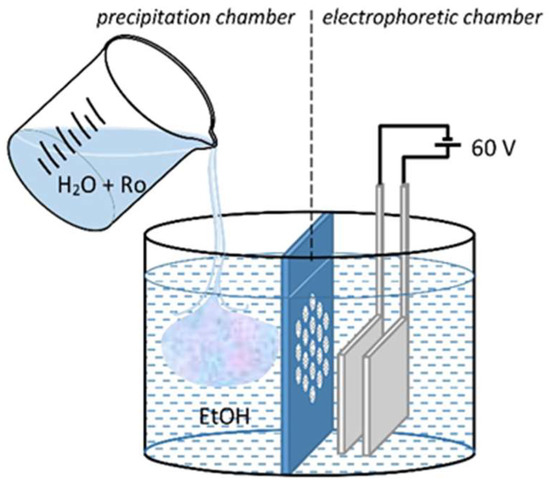
Figure 1.
Experimental setup for electrophoretic deposition in a two-chamber cell.
The two chambers of the bath were separated by a filter with an average pore diameter of 80 nm. Before starting the process, the aluminum electrodes were immersed in the electrophoretic chamber filled with ethanol and supplied with a constant voltage of 60 V. Next, a previously prepared tartrate aqueous solution was poured into the precipitation chamber (Figure 1). The voltage of 60 V (from power supply GW INSTEK GPR 11H30D) was optimally chosen so that it was high enough to ensure a high speed of electrophoretic deposition but without reaching gas-releasing and deep anodic oxidation of the aluminum anode, which negatively affects the quality of the deposited layer. After removal from the electrophoretic bath, the samples were allowed to dry on their own (without washing with water or drying with warm air). All tests of the obtained layers were carried out at least 24 h after they had been left at room temperature and humidity.
The filter of the electrophoresis bath is made of nanoporous anodic aluminum oxide obtained by unilaterally anodizing aluminum foil (the same used for electrodes) in 0.4 M oxalic acid at 40 V and 15 °C for 5 h. The resulting nanoporous layer has a thickness of 25 µm and a pore diameter of about 75–80 nm after pores widen in 5% phosphoric acid. To ensure the mechanical strength of the filter, a protective mask (the blue layer in Figure 2) and holes with a diameter of 2 mm are formed on the back side of the aluminum by photolithography with a dry photoresist. In the photoresist-unprotected areas, the aluminum is etched with a 0.1 M CuCl + 3 M HCl solution, and only a layer of transparent nanoporous anodic aluminum oxide remains in the holes of the aluminum substrate (Figure 2). The bottoms of the nanosized pores are dissolved with 5% H3PO4 and the oxide layer becomes permeable to solvents and particles below 80 nm.
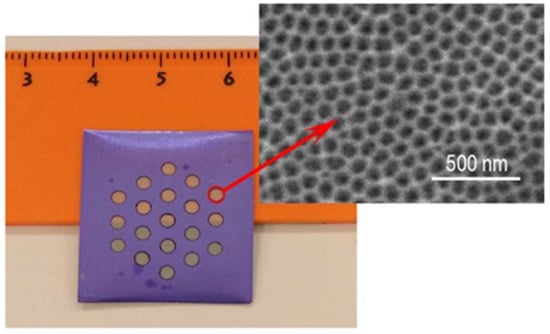
Figure 2.
The filter of anodic aluminum oxide over the aluminum mounting substrate.
Fourier Transformed Infrared (FTIR) spectrometer Agilent Cary 630 FTIR was used to determine the absorption bands of the material that were electrophoretically deposited on the anode and cathode. The spectrometer’s spectral range was 6300–350 cm−1 with a spectral resolution of 2 cm−1.
The morphology of the obtained electrophoretic anodic layers and their thickness were analyzed by Tescan LYRA SEM (scanning electron microscope) featuring an energy-dispersive X-ray (EDX) analyzer of Bruker AXS Microanalysis GmbH.
The X-ray diffraction (XRD) method was applied to determine the average dimension of RS crystallites on the Al-substrate. The XRD tool used was PANanalytical Empyrean Pixel 3D multichannel detector at Cu Kα =1.5406 Å to obtain the diffractograms in the 5–55° 2θ range, with 0.01° resolution.
To measure the piezo response of Rochelle salt piezo samples, an experimental electromechanical setup for measuring thin layers, developed at the Technical University of Sofia, was used [23]. A PolyK Piezo PVDF was used for the calibration of a piezoelectric meter (measured d33 = 27 pC/N). The experimental setup generates a cyclic mechanical force along the z-axis of the piezo layer, which can be varied from 0.0098 to 0.98 N with a frequency of 1 Hz to 20 kHz. In our experiments, a mechanical force of 0.0245 N and a frequency of 50 Hz were applied to patterns with an area of 1 cm2. A higher loading force (over 0.03 N) causes layer failure. A frequency of 50 Hz was chosen as the average value in the operating range of the experimental setup for test samples. The generated periodic voltage (V) from the piezo layer under the action of mechanical force was recorded by a digital oscilloscope (DQ2042CN Shanghai MCP Corp.) with an accuracy of 0.54 mV. Since the mechanical deformation is perpendicular to the piezo layer (along the z-axis), the Piezo modulus d33 can be described by Equation (1) [24]:
where the capacity (C) of the deposited structure was measured by RLC-type measurements (Instek LCR 819, Good Will Instrument Co., Ltd. Taipei, Taiwan).
3. Results and Discussion
3.1. Effect of Water/Ethanol Ratio on the Kinetics of the Electrophoretic Deposition
The tartrate particles are obtained by precipitation when mixing an aqueous solution of Rochelle salt and ethanol in the precipitation chamber of the experimental cell (Figure 1). Since the salt is practically insoluble in ethanol (anti-solvent), charged crystal particles of the salt of different sizes are released into the liquid phase, and the solution becomes cloudy. When a sufficiently high voltage of 60 V is applied, particles below 80 nm in size pass through the filter and are oriented toward the electrode. As a result of the migration, clouding of the alcohol was also observed in the electrophoresis chamber.
The kinetics of the electrophoretic process is studied by the change of the anodic current density ja with time. Figure 3 shows the dependencies obtained for mixtures 1, 3, and 6 corresponding to RS:H2O:EtOH ratios 1:10:40, 1:20:30, and 1:30:20, respectively. The electrophoretic process in mixture 1 with the lowest solvent–anti-solvent ratio (1:5) proceeds with a sharp initial peak in current density up to 57 mA cm−2, after which the process begins to rapidly decay, and at 30 s, the current drops below 1 mA cm−2. The relatively low current indicates that most of the Rochelle salt crystals do not pass into the electrophoresis compartment and do not contribute to the current signal. The greatest turbidity (opacity) of the solution was visually recorded. This result is expected considering that this mixture concentration of RS in the solvent is the highest, which suggests maximum rapid precipitation and the production of mostly large crystallites and agglomerates, which are characterized by slow mobility in an electric field and a size above that of the filter pores.

Figure 3.
Variation of anodic current density with time in the electrophoresis of Rochelle salt mixtures 1, 3, and 6 with solvent (water): anti-solvent (ethanol) ratios 1:5, 1:2, and 1:1. Inset represents the current density on a logarithmic scale.
The dependence in mixture 3 with a lower H2O:EtOH ratio of 1:2 has a similar course, but the peak value of ja is twice as high and reaches 112 mA cm−2. This result can be explained by the formation of a greater number of crystals with a size below 80 nm. The larger number of charged particles in the electrophoresis chamber allows the higher current density recorded to be reached. The decay time of the process is close to that of the first experiment in mixture 1 (falling below 1 mA cm−2 in 37 s), which can be more clearly observed on the logarithmic scale of the current density (Figure 3). It can be assumed that at these two solvent–anti-solvent ratios, a dense layer of Rochelle salt is deposited on the surface, which blocks the further process. The possibility of blockage of the filter pores by larger crystallites and depletion of charged particles in the electrophoretic deposition chamber was ruled out by conducting analogous experiments without the use of a filter, in which analogous dependencies were obtained.
Visual observations of mixture 6 show that the turbidity of the solution in the precipitation chamber is barely noticeable. Hence further increasing of the solvent–anti-solvent ratio of 1:1 results in incomplete precipitation of the Rochelle salt due to its higher solubility in the mixture. As a result, the peak current density is minimal (up to 43.5 mA cm−2). In this case, the current drops below 1 mA cm−2 in 20 s, probably as a result of the rapid depletion of charged particles (Figure 3). The release of gas bubbles begins on the anode, which is an indication of water electrolysis.
After the electrophoretic reactions, a slight matting of the aluminum anode was observed in all tests, while the cathode did not change its appearance. This suggests that electrophoretic deposition takes place on the anode, and it is also proved by FTIR for a sample of a 1:2 mixture of water/alcohol.
The absorption FTIR spectrum of the electrophoretically deposited layer of nanocrystalline Rochelle salt on the positive electrode is shown in Figure 4.
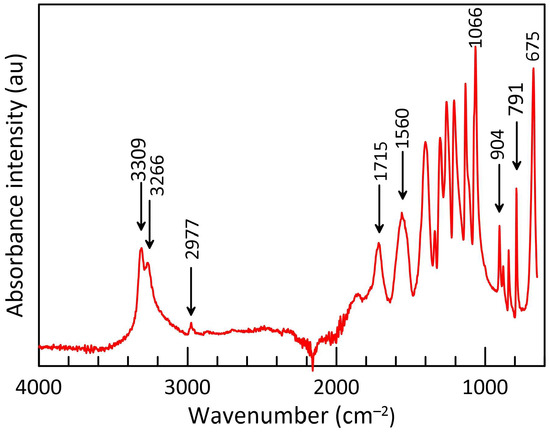
Figure 4.
FTIR spectra of RS on Al-anode.
In the spectra of Rochelle salt in the range of 3000–3500 cm−1, a broad absorption plateau due to hydrate water is usually observed [25,26]. In this interval, however, the spectrum in Figure 4 shows a significantly narrower absorption band with two merged peaks at 3308 and 3266 cm−1. The first peak is due to hydrated water, and the second peak corresponds to the presence of a carboxylic acid [27]. The weak peak at 2977 cm−1 corresponds to the C-H stretching [17,25]. Some authors interpret this relationship as the presence of a carboxylic acid in the crystal lattice [27]. The multiple peaks in the region 1600–600 cm−1 are typical for the different bonds and functional groups in the tartrate ion, such as C=O, C-C, and C-H stretching. The most intense peak at 1066 cm−1 is associated with C-C stretching vibrations [17]. The results prove the presence of Rochelle salt on the anode, while on the cathode, no significant peaks were identified in the region from 4000 to 600 cm−1, i.e., we have no RS deposition on the negative electrode.
3.2. Influence of the Water:Ethanol Ratio on the Structure of the Electrophoretic Coating
Figure 5 shows SEM images of an aluminum surface with electrophoretically deposited Rochelle crystallites from a mixture of RS:H2O:EtOH 1:30:30 without using a filter. The purpose of these experiments is to record the full variety of sizes and shapes of Rochelle salt crystals and their surface orientation during electrophoretic deposition without using a size-limiting barrier. From Figure 5a, it can be seen that the crystallites can be divided into two predominant groups: (i) rod-shaped with a large aspect ratio and (ii) larger three-dimensionally grown formations with an irregular shape. Some of the elongated rod-shaped crystallites exceed 50 µm in length and 1–2 µm in diameter. At a higher magnification of 10,000× (Figure 5b), it is seen that the irregularly shaped formations are also composed of individual rod-shaped crystals incorporated into larger agglomerates. A trend towards a perpendicular orientation of the rod-shaped crystals relative to the grip center is also observed. This fact indicates a different polarity of the two ends of the crystals, which may have been induced by the action of the electric field during their formation. The observations also show that the surface is irregularly covered, possibly due to the unevenness of the aluminum surface, which provokes a different distribution of the electric field. Because of this, the crystals are preferentially attached to certain areas until the formation of druses.
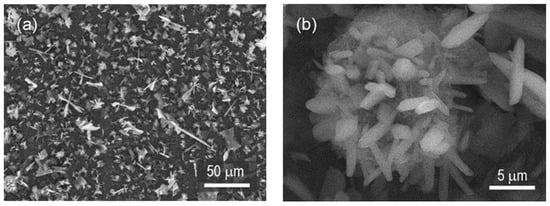
Figure 5.
SEM images of Rochelle salt crystals electrophoretic deposited from a 1:30:30 RS:H2O:EtOH mixture without using filler: (a) top view and (b) single druse.
The smallest of the observed crystals have a diameter of 50–80 nm and a length of about 2 µm (Figure 5b). It can be assumed that the crystals trapped on the surface are a representative sample of those present in the heterogeneous water-ethanol-Rochelle salt mixture, especially those that are of suitable size, polarity, and orientation for their electrophoretic movement under the action of the high electric field towards the positive electrode. The size of the primary deposited crystals cannot be clearly determined. There seem to be all sizes and shapes on the aluminum surface. No preferential primary deposition of the smallest size crystals was observed. Rather, after blocking the surface by the primary deposited layer, subsequent crystals are preferentially deposited on some specific and more active areas, possibly concentrating the electric field. The lighter color of the Rochelle salt crystals is due to both their more protruding surface and their lower conductivity, which results in charging in the electron beam scan during SEM observations.
The change in morphology of the deposited piezoelectric layers from different RS:H2O:EtOH ratios when using a filter was investigated by surface and cross-sectional SEM observations. Some typical SEM images of the different layers tested are presented in Figure 6, Figure 7 and Figure 8.

Figure 6.
SEM images of a piezoelectric layer formed from mixture 1 (Ro:H2O:EtOH 1:10:50) at (a) 50 µm and (b) 5 µm magnification..
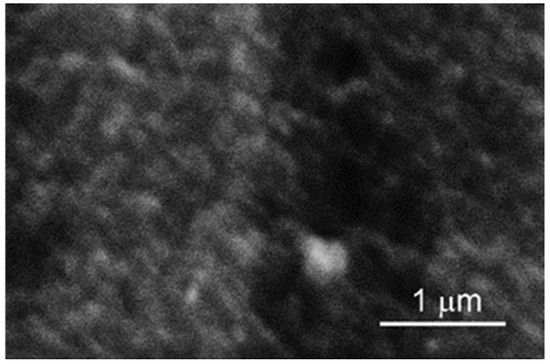
Figure 7.
SEM images of a piezoelectric layer formed from mixture 3 (ratio of RS:H2O:EtOH 1:20:40).

Figure 8.
SEM images (a) top view and (b) cross-section of a piezoelectric layer formed from mixture 5 at a ratio of RS:H2O:EtOH 1:25:35.
The filter between the two chambers will limit the size and amount of crystals that can reach the surface if we assume that when the amount of anti-solvent (EtOH) dominates, the Rochelle salt crystals form entirely in the precipitation chamber. At the same time, this will cause the crystals to be deposited in increasing size order because the rate of particle transport in electrophoresis depends on their size. Figure 6 shows an electrophoretic deposited layer of mixture 1 with the maximal amount of anti-solvent (ratio of RS:H2O:EtOH 1:10:50).
At low magnifications of about 1000× (Figure 6a), an unevenly deposited layer is visible, which follows the shape of the substrate and is cut by numerous point defects. At higher magnifications (Figure 6b), it can be seen that the darker point defects on the surface are areas with a thinner or absent light tartrate layer. The lighter sections of the surface primarily reside on the protrusions, but not only; therefore, they are more likely to be associated with a layer of Rochelle salt that formed during the scan that was denser and/or thicker due to being charged by the electron beam. These observations support the assumption made above that in the case of mixture 1, the amount of nanosized crystals passing through the filter is limited. This may be a result of the higher number of agglomerates over 80 nm in size and the rapid clogging of the filter. The first passed crystals are directly attached to regions of the substrate characterized by a stronger electric field (such as protrusions and those with a thinner natural passive layer on aluminum, such as edges and point defects). The amount of tartrate nanocrystals is probably not enough to densely cover the surface. At magnifications above 10,000×, differently oriented submicron rod-shaped light crystallites with a diameter < 80 nm and a length of 1–2 µm are also observed (Figure 6b). These observations indicate that larger single crystals are able to orient themselves and pass through the filter under the action of the high electric field. They reach the surface last because of their larger size, and they are deposited on top of the primary thin Rochelle salt layer that has previously formed.
The observed layers obtained from mixture 3 (RS:H2O:EtOH ratio of 1:20:40), with a higher solvent content compared to that of mixture 1, are characterized by a significantly more uniform thin layer. The presence of a layer is noticeable only at magnifications above 20,000× (Figure 7). The surface appears to be relatively uniformly covered with densely spaced acicular crystals of about and below 80 nm in diameter, located perpendicular to the surface. The likely reason for the more uniform deposition is the slower precipitation and the possibility of a greater number of nanocrystals below 80 nm to pass through the membrane, reach and deposit simultaneously on the substrate.
The observations for layers deposited from mixture 5 at a ratio of RS:H2O:EtOH 1:25:35 are similar (Figure 8a). A cross-sectional view (Figure 8b) shows a dense layer of needle-like crystallites about 4 µm long and <80 nm thick, oriented perpendicular to the Al substrate (left) until forming a dense layer. The better results obtained with increasing the amount of water in the mixture indicate a ratio of solvent/anti-solvent, which provides a greater number of crystals with a size below 80 nm that could be oriented by an electric field and pass through the membrane. Probably the higher content of the solvent (water) leads to the formation of a larger number of single crystals, and their agglomeration is reduced. The polarized nano-sized crystals are orientated perpendicular to the surface and become evenly distributed on the substrate under the influence of the high electric field without being seen as preferred sites of aggregation or uncovered areas.
When the amount of solvent equaled or exceeded that of the anti-solvent, as in mixtures 6 and 7 (RS:H2O:EtOH 1:30:30 and 1:35:25), crystals larger than 80 nm were observed deposited on the aluminum substrate. Figure 9a, for instance, depicts a layer with non-uniformly distributed larger crystals and preferential layer deposition on the elevated areas (light lines). In Figure 9b, at higher magnification, a typical ill-formed crystal is seen, about 0.5 microns thick and about 2 microns long.

Figure 9.
SEM images of the surface after electrophoresis of mixture 7 (RS:H2O:EtOH 1:35:25): (a) top view and (b) single crystal.
This phenomenon occurs because the precipitation process is slowed down by the high solvent content. This enables the tartrate molecules to flow through the 80 nm-sized membrane under the influence of diffusion and electromotive force and the primary precipitation to occur close to the electrode surface, where the ethanol amount at the beginning of the process is locally higher. This makes it possible to deposit on the anode crystals of various sizes that are larger than the filter. Therefore, the filter does not act as a limiter of the dimensions of the deposited crystals. The other reason for the inhomogeneous deposition of the Rochelle salt layer is the electrolysis of water and the appearance of gas bubbles on the surface of the electrodes, which makes it difficult to deposit the crystals or break off already deposited ones.
From the SEM images of the electrophoretically deposited layers, the best and the most homogeneous layer is deposited from a concentration of RS:H2O:EtOH 1:25:35. It is observed that the crystallites are needle-like with a diameter of up to 80 nm. X-ray diffraction analysis was used to accurately determine the orientation and average size of the crystallites in this electrophoretic deposition.
The XRD pattern is presented in Figure 10. The two intensive peaks at 2θ = 38.37° and 44.62° correspond to the aluminum substrate. The peak at 24.01° degree is indicative of the presence of tartrate and corresponds to the crystal plane (221) [28], which is evidence of preferential orientation of this direction towards the substrate plane. The additional diffraction peak of low intensity at 46.9° is related to aluminum oxyhydroxide, which is a product of anodic polarization of the aluminum substrate (boehmite AlOOH, JCPDF 21-1307) [29].
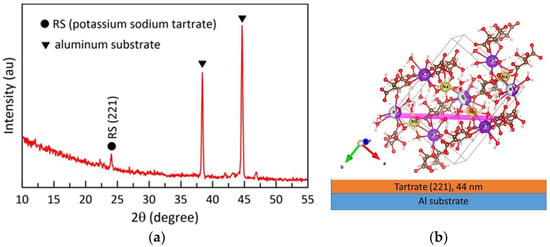
Figure 10.
X-rays diffractogram RS on Al-substrate (a); schematic of plane (221) parallel to Al-substrate (b).
The mean crystallite size is estimated to be 44 nm, according to Scherrer treatment of the full-width half maximum of this peak [30]. As it can be observed on SEM images (Figure 8) that the needle-like structures are stacked horizontally across the Al-substrate, it can be assumed that the dimension obtained from the Scherrer analysis corresponds to the width of the needle, also indicating that their growth is in the (221) direction.
3.3. Piezo Effect
The data for the piezo effect as capacitance (C), root-mean-square voltage (VRMS), peak-to-peak voltages (VPP), and piezo module (d33) of deposited layers at different solvent/anti-solvent ratios are presented in Table 2.

Table 2.
The general electrical parameters of piezo layers obtained from mixtures with different ratios of RS:H2O:EtOH under the application of mechanical pressure F from 0.0245 N.
The peak-to-peak voltages VPP obtained from the samples are hundreds of millivolts, with the maximum being 1.33 V for an electrophoretic deposited layer of mixture 3 (RS:H2O:EtOH 1:20:40), which guarantees good sensitivity when using them in applications.
The resulting hundreds of pC/N piezo modulus are comparable to the piezo modulus of inorganic single crystals and ceramic structures [31], i.e., biocompatible Rochelle salt may concur with these materials. The maximum measured value of the piezo modulus is for the layer obtained from mixture 4 (RS:H2O:EtOH 1:22.5:37.5). Its value is 1120 pC/N which is comparable to the piezo modulus of single crystal RS (which varies from tens of pC/N to 2300 pC/N depending on the orientation [31,32,33] although the layers are composed of nano-polycrystals.
Figure 11 shows the dependence of the piezo modulus on the solvent/anti-solvent ratio in the mixtures from which the electrophoretic deposition of the layers was performed. The lowest piezo response values were obtained for the layers deposited in mixtures 1 and 2, corresponding to minimum solvent content. As noted above in the morphological characterization of the layers, these layers are the most uneven and defect-rich, which reflects a decrease in the piezo response.
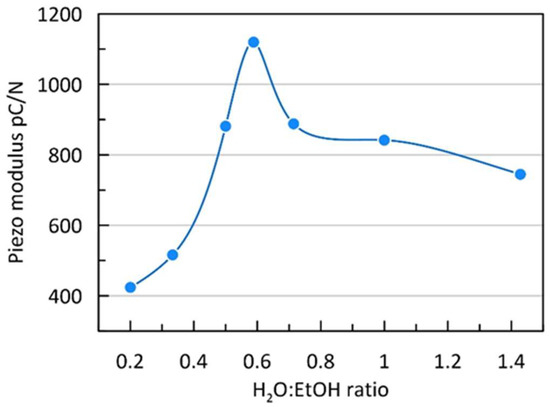
Figure 11.
Dependence of the piezo modulus on the water-ethanol ratio.
As the content of the solvent increases, an increase in the piezo modulus is observed, with its peak value of 1120 pC/N in mixture 4 (RS:H2O:EtOH 1:22.5:37.5). This result can be related to the morphological observations, according to which the most homogeneous layers and uniformly oriented nanocrystals were observed at this S:AS ratio (Figure 8). Therefore, improving the uniformity of the deposited piezoelectric layer, as well as its construction of preferentially oriented acicular crystals tightly contacting each other, ensures the generation of maximum response.
When the S:AS ratio was further increased from 1:1.7 to 1:0.7 (from mixture 4 to 7, respectively), a decrease in the piezo response of the obtained samples was observed. Therefore, the presence of larger Rochelle salt crystallites deposited on the primary acicular layer (Figure 9) degrades the generated piezo response either due to an increase in inhomogeneity or a worsening of the contact between the dense acicular layer and the measuring probe. Therefore, the piezo response directly depends on the S:AS ratio, which determines the kinetics of the reaction and the structure of the deposited layer.
4. Conclusions
We have demonstrated a new approach for the deposition of piezo salts by an anti-solvent method. In particular, we examined the characteristics of electrophoretic deposition of a piezoelectric tartrate layer from mixtures of Rochelle salt, water, and ethanol. The spatial separation of the anti-solvent precipitation and electrophoretic deposition processes into two separate chambers using a nanoscale filter was shown to allow the formation of a uniform piezoelectric layer. A wide range of solvent (water): anti-solvent (ethanol) ratios from 1:5 to 1:0.7 have been studied. The kinetics of the electrophoretic deposition process, as well as the morphology of the resulting layers, strongly depend on the solvent:anti-solvent ratio. Our results prove that this ratio determines both the shape and size of the Rochelle salt crystals and the placement of their growth in the precipitation chamber or on the other side of the filter near the electrode surface. Mixtures with RS:H2O:EtOH ratios of 1:20:40 and 1:22.5:37.5 (mixtures 3 and 4) were determined as the most optimal from the point of view of process kinetics, layer uniformity, and piezo response. The resulting layers are made up of densely packed needle-like crystals of Rochelle salt with a length of 2–4 µm and a diameter of up to 80 nm. The voltage generated by these layers exceeds 1.2 V, and the measured piezo modulus for the blend 4 layer is 1120 pC/N. The electrical characteristics of the layers show that they have a high piezo response, comparable to a mono crystal and rivaling the piezo response of traditional materials such as quartz and PZT obtained by high-temperature and expensive technologies. Therefore, electrophoretic deposition allows us to make low-cost piezo layers in a short time frame over a large area. The proposed method is compatible with modern dry electronics manufacturing technologies and may find applications in green electronics fabrications such as energy harvesting systems. Future work will focus on using it for the deposition of other piezo salts and thin film composites of piezo salts with organic polymers.
Author Contributions
Conceptualization, R.R.; Methodology, R.R., B.T. and G.A.; Formal analysis, G.A.; Investigation, R.R. and B.T.; Data curation, B.T.; Writing—original draft, R.R. and B.T.; Writing—review & editing, G.A. All authors have read and agreed to the published version of the manuscript.
Funding
This work was financially supported by the Bulgarian National Science Found, research project KΠ-06-H57/15 (16.11.2021).
Institutional Review Board Statement
Not applicable.
Informed Consent Statement
Not applicable.
Data Availability Statement
Not applicable.
Conflicts of Interest
The authors declare no conflict of interest.
References
- Lee, J.H.; Yoon, B.S.; Park, J.-W.; Song, G.; Yoon, K.J. Flexural Deflection Prediction of Piezo-Composite Unimorph Actuator Using Material Orthotropy and Nonlinearity of Piezoelectric Material Layer. Coatings 2020, 10, 437. [Google Scholar] [CrossRef]
- Vijaya, M.S. Piezoelectric Materials and Devices Applications in Engineering and Medical Sciences, 1st ed.; CRC Press: Boca Raton, FL, USA, 2012. [Google Scholar] [CrossRef]
- Andrusyk, A. Piezoelectric Effect in Rochelle Salt. In Ferroelectrics-Physical Effects; Mickaël, L., Ed.; IntechOpen: Rijeka, Croatia, 2011; pp. 195–220. ISBN 978-953-307-453-5/978-953-51-4457-1. [Google Scholar] [CrossRef]
- Fu, D.; Itoh, M.; Koshihara, S. Crystal growth and piezoelectricity of BaTiO3–CaTiO3 solid solution. Appl. Phys. Lett. 2008, 93, 012904. [Google Scholar] [CrossRef]
- Golovanov, E.; Kolesov, V.; Anisimkin, V.; Osipenko, V.; Kuznetsova, I. ZnO Piezoelectric Films for Acoustoelectronic and Microenergetic Applications. Coatings 2022, 12, 709. [Google Scholar] [CrossRef]
- Wang, Z.L. Piezotronics and Piezo-Phototronics; Springer: Berlin/Heidelberg, Germany, 2012; Hardcover ISBN 978-3-642-34236-3. Softcover ISBN 978-3-662-51112-1. eBook ISBN 978-3-642-34237-0. [Google Scholar] [CrossRef]
- Suaste-Gomez, E. Piezoelectric Ceramics; IntechOpen: Rijeka, Croatia, 2010; ISBN 978-953-307-122-0/978-953-51-5921-6. [Google Scholar] [CrossRef]
- Lee, J.; Lim, S. Polarization behavior of polyvinylidene fluoride films with the addition of reduced graphene oxide. J. Ind. Eng. Chem. 2018, 67, 478–485. [Google Scholar] [CrossRef]
- Jeronimo, K.; Koutsos, V.; Cheung, R.; Mastropaolo, E. PDMS-ZnO Piezoelectric Nanocomposites for Pressure Sensors. Sensors 2021, 21, 5873. [Google Scholar] [CrossRef]
- Shakeri, A.; Golobostanfard, M.R.; Abdizadeh, H. Multi-stacked hard/soft Pb(Ti,Zr)O3 films deposited through wet chemical method. Mater. Chem. Phys. 2021, 267, 124637. [Google Scholar] [CrossRef]
- Raunak, A.; Ali, W.R.; Prasad, M. Deposition and optimization of piezoelectric zinc oxide-layer using sol-gel technique for MEMS acoustic sensor. Mater. Today Proc. 2021, 46, 5730–5736. [Google Scholar] [CrossRef]
- Chadha, U.; Bhardwaj, P.; Agarwal, R.; Rawat, P.; Agarwal, R.; Gupta, I.; Panjwani, M.; Singh, S.; Ahuja, C.; Selvaraj, S.K.; et al. Recent progress and growth in biosensors technology: A critical review. J. Ind. Eng. Chem. 2022, 109, 21–51. [Google Scholar] [CrossRef]
- Denning, D.; Paukshto, M.; Habelitz, S.; Rodriguez, B.J. Piezoelectric properties of aligned collagen membranes. J. Biomed. Mater. Res. Part B Appl. Biomater. 2013, 102, 284–292. [Google Scholar] [CrossRef]
- Hoque, N.A.; Thakur, P.; Biswas, P.; Saikh, M.M.; Roy, S.; Bagchi, B.; Das, S.; Ray, P.P. Biowaste crab shell-extracted chitin nanofiber-based superior piezoelectric nanogenerator. J. Mater. Chem. A 2018, 28, 13848–13858. [Google Scholar] [CrossRef]
- Tien, C.; Charnaya, E.V.; Lee, M.K.; Baryshnikov, S.V.; Michel, D.; Böhlmann, W. NMR studies of structure and ferroelectricity for Rochelle salt nanoparticles embedded in mesoporous sieves. J. Phys. Condens. Matter 2008, 20, 215205. [Google Scholar] [CrossRef]
- Lemaire, E.; Moser, R.; Borsa, C.J.; Briand, D. Green paper-based piezoelectronics for sensors and actuators. Sens. Actuators A: Phys. 2016, 244, 285–291. [Google Scholar] [CrossRef]
- Lemaire, E.; Ayela, C.; Atli, A. Eco-friendly materials for large area piezoelectronics: Self-oriented Rochelle salt in wood. Smart Mater. Struct. 2018, 27, 025005. [Google Scholar] [CrossRef]
- Yoshioka, T.; Chávez-Valdez, A.; Roether, J.A.; Schubert, D.W.; Boccaccini, A.R. AC electrophoretic deposition of organic-inorganic composite coatings. J. Colloid Interface Sci. 2013, 392, 167–171. [Google Scholar] [CrossRef] [PubMed]
- Usha Kiran, N.; Dey, S.; Singh, B.P.; Besra, L. Graphene Coating on Copper by Electrophoretic Deposition for Corrosion Prevention. Coatings 2017, 7, 214. [Google Scholar] [CrossRef]
- Wang, L.M. Effect of surfactant BAS on MoS2 codeposition behaviour. J. Appl. Electrochem. 2007, 38, 245–249. [Google Scholar] [CrossRef]
- Hong, I.K.; Park, J.W.; Lee, S.B. Balancing of plating solution in CuCN electroplating process. J. Ind. Eng. Chem. 2014, 20, 3068–3074. [Google Scholar] [CrossRef]
- Rusev, R.P.; Angelov, G.V.; Tzaneva, B.R.; Aleksandrova, M.P. Electrophoretic Deposition of Rochelle Salt on Cu2O Plate. In Proceedings of the 56th International Scientific Conference on Information, Communication and Energy Systems and Technologies (ICEST), Sozopol, Bulgaria, 16–18 June 2021; pp. 107–110. [Google Scholar] [CrossRef]
- Aleksandrova, M.; Kurtev, N.; Videkov, V.; Tzanova, S. Material alternative to ITO for transparent conductive electrode in flexible display and photovoltaic devices. Microelectron. Eng. 2015, 145, 112–116. [Google Scholar] [CrossRef]
- Liu, J.-M.; Pan, B.; Chan, H.L.W.; Zhu, S.N.; Zhu, Y.Y.; Liu, Z.G. Piezoelectric coefficient measurement of piezoelectric thin films: An overview. Mater. Chem. Phys. 2002, 75, 12–18. [Google Scholar] [CrossRef]
- Evangelin Teresa, P.; Sornambol, M.; Gowri, S.; Aarthi, J.; Navina, M. Growth, spectral, dielectric, magnetic and antimicrobial studies on dye doped rochelle salt crystal. Results Mater. 2020, 6, 100095. [Google Scholar] [CrossRef]
- Mathivanan, V.; Haris, M. Studies on solution-grown pure and doped Sodium Potassium tartrate crystals. Spectrochim. Acta Part A Mol. Biomol. Spectrosc. 2013, 102, 341–349. [Google Scholar] [CrossRef]
- Shyju, T.S.; Anandhi, S.; Gopalakrishnan, R. Comparative studies on conventional solution and Sankaranarayanan–Ramasamy (SR) methods grown potassium sodium tartrate tetrahydrate single crystals. CrystEngComm 2012, 14, 1387–1396. [Google Scholar] [CrossRef]
- Rakesh, M.; Narendra Babu, B.R. Investigational study of Material Morphology, Structure and Conductivity characteristics of Rochelle salt based PVDF composites. Int. Res. J. Eng. Technol. (IRJET) 2022, 9, 778–784, p-ISSN 2395-0072. e-ISSN 2395-0056. [Google Scholar]
- Kartikaningsih, D.; Shih, Y.-J.; Huang, Y.-H. Boron removal from boric acid wastewater by electrocoagulationusing aluminum as sacrificial anode. Sustain. Environ. Res. 2016, 26, 150–155. [Google Scholar] [CrossRef]
- Jenkins, R.; Snyder, R.-L. Introduction to X-ray Powder Diffractometry; Wiley: New York, NY, USA, 1996; ISBN 978-0-471-51339-1. [Google Scholar]
- Tressler, J.F.; Alkoy, S.; Newnham, R.E. Piezoelectric Sensors and Sensor Materials. J. Electroceram. 1998, 2, 257–272. [Google Scholar] [CrossRef]
- Xu, Y. Ferroelectric Materials and Their Applications; North-Holland: Amsterdam, The Netherlands, 1991; ISBN 0444883541/9781483290959. [Google Scholar]
- Choy, M.M.; Cook, W.R.; Hearmon, R.F.S.; Jaffe, J.; Jerphagnon, J.; Kurtz, S.K.; Liu, S.T.; Nelson, D.F. Landolt—Bornstein: Numerical data and functional relationships in science and technology new series. In Group III: Crystal and Solid State Physics, Elastic, Piezoelectric, Pyroelectric, Piezooptic, Electrooptic Constants, and Nonlinear Dielectric Susceptibilities of Crystals; Kellwege, K.-H., Hellwege, A.M., Eds.; Springer: Berlin, Germany, 1979; Volume 11. [Google Scholar]
Disclaimer/Publisher’s Note: The statements, opinions and data contained in all publications are solely those of the individual author(s) and contributor(s) and not of MDPI and/or the editor(s). MDPI and/or the editor(s) disclaim responsibility for any injury to people or property resulting from any ideas, methods, instructions or products referred to in the content. |
© 2023 by the authors. Licensee MDPI, Basel, Switzerland. This article is an open access article distributed under the terms and conditions of the Creative Commons Attribution (CC BY) license (https://creativecommons.org/licenses/by/4.0/).